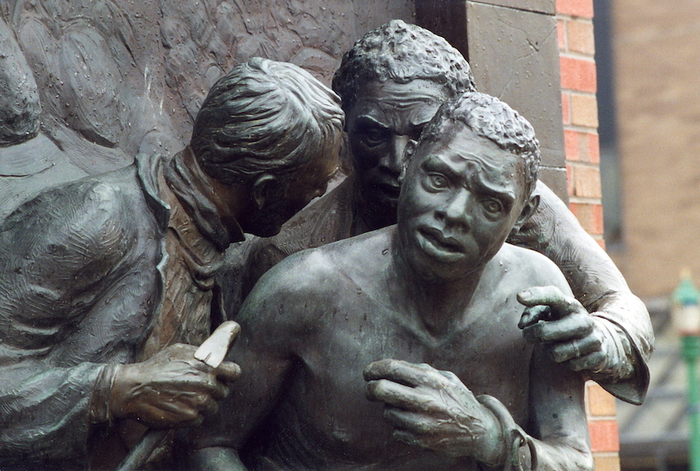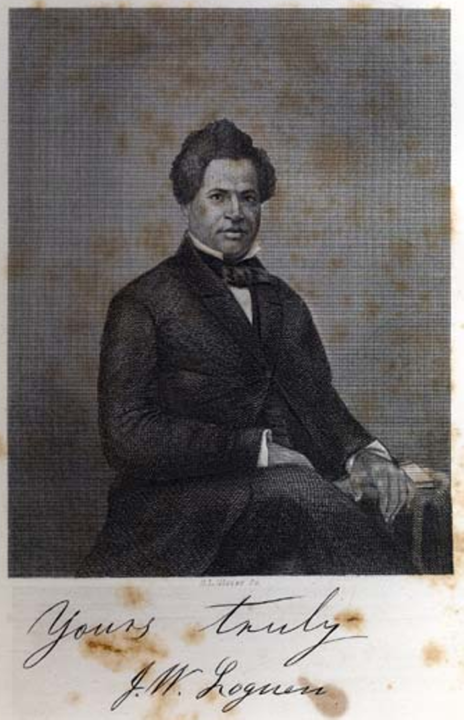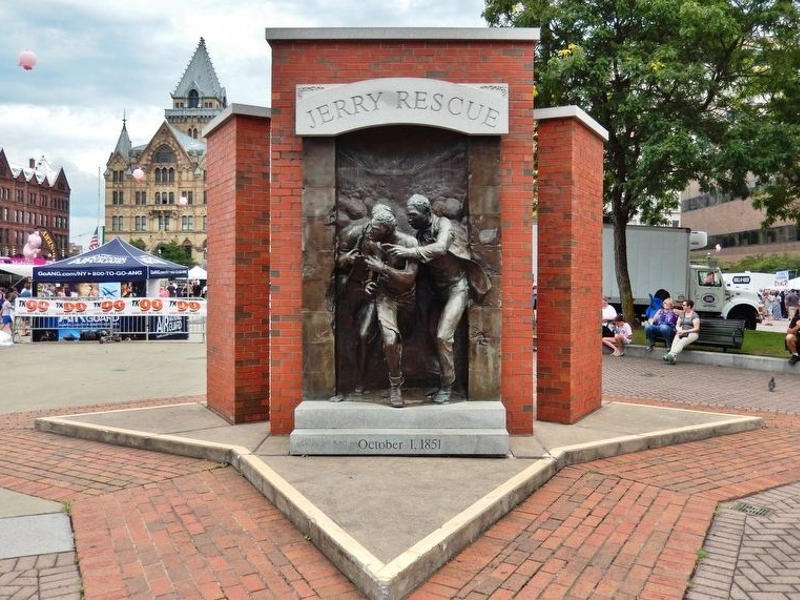Jerry Rescue Monument. Photographed By Cosmos Mariner, August 17, 2019. Source: The Historical Marker Database
Jerry Rescue Day, observed on October 1, commemorates a pivotal event in American history that unfolded on the same day in 1851. This significant occasion marks the public rescue of a fugitive slave named William Henry, known as “Jerry,” who had been apprehended in Syracuse, New York. The Jerry Rescue was a remarkable demonstration of defiance against the institution of slavery and a testament to the commitment of abolitionists in the North to protect the rights and freedom of enslaved individuals. This article explores the historical importance of Jerry Rescue Day, shedding light on the background, planning, rescue, and subsequent impact of this courageous act.
Background: A Hub of Abolitionist Activity
New York State was characterized by its sympathetic stance toward enslaved individuals, as it was a free state on the border of the slaveholding South. Abolitionist sentiments ran deep, especially in Syracuse, primarily influenced by individuals like Gerrit Smith and Reverend Samuel May. Prominent figures such as Frederick Douglass, Matilda Joslyn Gage, John W. Jones, William Marks, and Harriet Tubman were actively involved in the abolitionist movement in the area. Syracuse, often referred to as the “great central depot on the Underground Railroad,” played a crucial role in aiding escaping slaves on their journey to freedom in Canada.
The passage of the Fugitive Slave Act of 1850 profoundly agitated the abolitionist community in Syracuse. This law allowed enslavers to recapture escaped enslaved people, even in free states, and imposed severe penalties on anyone aiding a fugitive. Abolitionists like Samuel May organized protests, and even British abolitionist George Thompson spoke against the law in Syracuse. Secretary of State Daniel Webster’s visit to the city further exacerbated tensions, as he threatened to enforce the Fugitive Slave Law during the next Anti-Slavery Convention held in Syracuse.
Early Life of Jerry: A Life in Slavery
Initially named William Henry, Jerry was born into slavery in North Carolina in 1811. He was owned by William Henry, who had inherited Jerry’s mother, Ciel, through marriage. It is believed that Jerry was the son of William Henry due to his red hair and light skin tone. In 1818, the Henry family moved to Missouri, taking Jerry with them. He grew up in Missouri, honing his skills as a carpenter and cooper, known for his exceptional craftsmanship in making chairs.
Jerry’s journey to freedom began in 1843 when he fled from Missouri. His escape route took him through various places, including Chicago and Milwaukee, where he evaded capture. However, his owner, William Henry, sold his rights to Jerry to Thomas Miller for $400, making it legally possible for Miller to pursue Jerry.
Jerry’s Arrival in Syracuse: A Fateful Decision
In the winter of 1849/1850, Jerry arrived in Syracuse, drawn by the city’s reputation for its anti-slavery stance. He found employment under Charles F. Williston as a cabinet maker, but due to the opposition of Williston’s shop workers, Jerry eventually left to work at Morrell’s cooperage for better wages. Despite establishing himself in the community, Jerry faced frequent unjust arrests for crimes he did not commit, primarily due to his troubled relationship with Sarah Colwell.
Jerry’s ownership had been transferred to William Henry’s stepson, John McReynolds, for $400 under the Fugitive Slave Law of 1850. Unaware of this development, Jerry faced the imminent threat of being returned to slavery.
Planning the Rescue: Defiance without Violence
The plan to rescue Jerry was devised by the Syracuse Vigilance Committee and aimed to ensure Jerry’s escape without resorting to violence. The project relied on stealth and swiftness. A horse and buggy were prepared near the police station to transport Jerry, with the crowd breaking into the police office at a prearranged signal. The rescue participants were explicitly instructed to avoid causing harm.

The Jerry Rescue Monument in Syracuse depicts Jerry fleeing with the aid of white abolitionist Samuel J. May and former slave and Underground Railroad leader Jermain Loguen. Source: Curtin Archeological Consulting
The Rescue: A Bold Act of Defiance
On October 1, 1851, the day of Jerry’s arrest, a Liberty Party meeting took place in the Syracuse Congregationalist Church, attended by prominent abolitionists, including Gerrit Smith. Smith played avital role in securing Jerry’s passage to safety in Canada due to his wealth and connections.
The rescue unfolded as Jerry’s defenders, including Smith and Samuel May, arrived at the police office. The crowd urged Jerry to escape, and he fled. Although he was recaptured, his escape garnered significant support from bystanders who were appalled by the treatmen he received. As the trial proceeded, the anger among the crowd grew, leading to a decisive moment.
At 8:00 p.m., a group of people armed with weapons stormed the police office, extinguishing the gas lights to make Jerry’s defense more challenging. The outnumbered guards relinquished Jerry to his rescuers, who swiftly transported him to safety.
Hiding and Escape to Canada: A Remarkable Journey
Jerry was taken to Lucy Watson’s home, where his wounds were tended to and his shackles removed and buried. He was dressed in women’s clothes as a disguise and brought to Caleb Davis’s home, an unexpected ally. Despite his anti-abolitionist views, Davis harbored Jerry because he resented government interference in local matters.
After spending four days in hiding, Jerry’s escape continued. Some accounts suggest he was hidden at the bottom of a cart, while others claim that James Davis and Jason Hoyt were responsible for his transportation. Jerry’s journey eventually led him to an Underground Railroad station in Mexico, New York, from where he crossed Lake Ontario into Canada. He settled in Kingston, Ontario, where he worked as a cooper and carpenter, finally enjoying the freedom he had longed for.
Arrest and Trial of Rescue Participants: Mixed Outcomes
Following the rescue, several participants were arrested and tried for their actions. Supporters, including U.S. Senator William H. Seward, raised funds to pay their bonds. While some were charged, nine others, including Reverend Jermain Wesley Loguen, fled to Canada to avoid prosecution. The trials of the rescuers were repeatedly postponed, and the outcomes varied. Enoch Reed, one of the rescuers, was tried and found “not guilty” of violating the Fugitive Slave Law, as it was never established that John McReynolds had a valid claim to Jerry’s service. Ultimately, only one man was convicted on a minor charge, and the charges against the remaining defendants were not dropped until June 1861.

Engraving of Jeremy Loguen from his 1859 Autobiography. Public Domain
Jerry Rescue Building and Monument: Honoring a Legacy
The memory of the Jerry Rescue was preserved in Syracuse’s history. In the 1850s, the Townsend Block was renamed the Jerry Rescue Building, although it no longer stands today. A monument in Clinton Square now commemorates the event, ensuring that future generations remember this significant act of defiance against slavery.
Jerry Rescue Day: A Celebration of Freedom
Jerry Rescue Day was instituted as an annual event to honor the memory of Jerry’s rescue and celebrate his journey to freedom. It was celebrated every October 1 until the outbreak of the Civil War, and the day involved speeches, poetry readings, songs, and resolutions upholding the right to resist slavery-related laws. Funds were collected to support the legal expenses of the rescuers and sustain the Underground Railroad in central New York.
As time passed, some celebrations began to advocate for a more militant approach to defending fugitive slaves, a concept championed by figures like Frederick Douglass. However, the celebrations eventually ceased due to the frustration of key organizers, including Gerrit Smith, with the limited progress toward emancipation in the country. It was not until the 150th anniversary of the event in 2001 that a reenactment and monument were erected in honor of Jerry Henry.

Anand Subramanian is a freelance photographer and content writer based out of Tamil Nadu, India. Having a background in Engineering always made him curious about life on the other side of the spectrum. He leapt forward towards the Photography life and never looked back. Specializing in Documentary and Portrait photography gave him an up-close and personal view into the complexities of human beings and those experiences helped him branch out from visual to words. Today he is mentoring passionate photographers and writing about the different dimensions of the art world.





